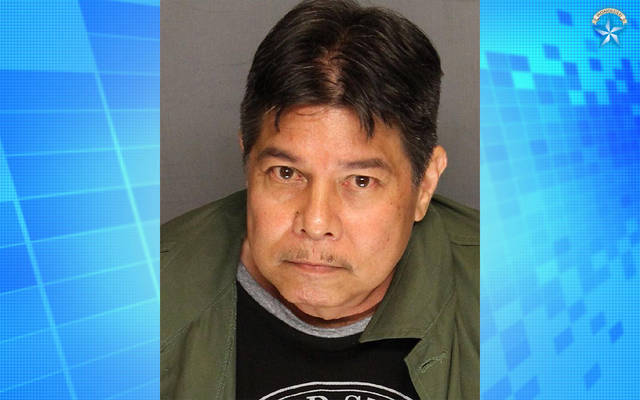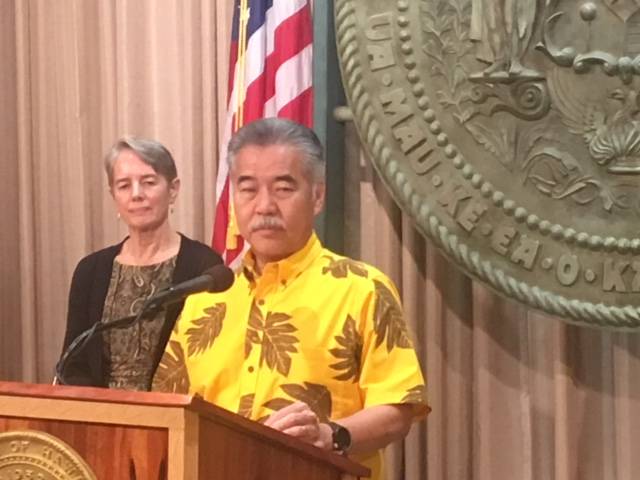7 hospital workers put on unpaid leave in escape’s aftermath


COURTESY SAN JOAQUIN COUNTY SHERIFF’S OFFICE
Randall Saito was arrested in California after he escaped from Hawaii State Hospital in Honolulu on Sunday.

COURTESY SAN JOAQUIN COUNTY SHERIFF’S OFFICE
Randall Saito

CRAIG T. KOJIMA / CKOJIMA@STARADVERTISER.COM
State Department of Health director Virginia Pressler stands behind Gov. David Ige during a press conference today.




Update: 3:39 p.m.
Seven Hawaii State Hospital employees were placed on leave without pay for 30 days pending the investigation of the escape of patient Randall Saito on Sunday, state Department of Health officials said this afternoon.
“As the investigation progresses, more employees may be identified and placed on off-duty status,” they said in a news release.
Department officials also said that all unescorted on-campus and off-campus privileges have been stopped, visits to Kaneohe Clubhouse have been suspended, and all levels of patient privilege and visitation policies are being reviewed.
Security staff have been reassigned and additional security fencing is being expedited, officials added.
Update 1:15 p.m.
Don't miss out on what's happening!
Stay in touch with breaking news, as it happens, conveniently in your email inbox. It's FREE!
An undisclosed number of the Hawaii State Hospital’s 630 employees are being placed on unpaid leave today as the state Attorney General’s office investigates how Randall Saito was able to leave the hospital grounds, hail a cab, fly to Maui and then get on another flight to California, where he was captured today, Gov. David Ige announced today.
Attorney General Doug Chin said Saito will face an extradition hearing in San Joaquin County “within days.” Once he’s back in Hawaii, Chin said his office plans to make a case before a judge that Saito is not suffering from a mental defect.
“This was premeditated,” Chin said. “It was intentional. It was planned. This was something that wasn’t done by somebody suffering from a mental defect.”
At the same time, Ige said visits have been suspended to the hospital’s club house; patient privileges are being reviewed; all staff are being retrained “on accountability;” security is being reassigned to the area; and fencing and other physical barriers are being procured.
Ige expressed frustration that hospital officials took 10 hours to notify law enforcement that Saito had escaped, made his way to Maui and was en route to California.
Ige called the delay “totally unacceptable. Clearly we need to know where these patients are, especially those that can be a danger to our community and we need to account for their whereabouts. … Clearly Randall Saito is not one who should have been allowed to leave the facility unescorted. … We will be investigating the specifics of what happened and we will make changes.”
Health Director Ginny Pressler, like Chin, declined to go into details of Saito’s escape from the Kaneohe hospital, which holds 202 patients, its allowable capacity.
Hospital employees on several shifts violated hospital protocols and procedures, Pressler said. Some employees, she said, “apparently weren’t doing their job.”
Update 12:50 p.m.
Captured Hawaii State Hospital escapee Randall Saito will remain in custody of the San Joaquin County (Calif.) Sheriff’s Office until he is extradited to Hawaii, according to spokesman Detective Dave Konecny.
Konecny credited the Stockton, Calif., cab driver who alertly contacted authorities after recognizing Saito from numerous media reports of his escape from the Kaneohe hospital.
The sheriff’s office also was on alert for Saito after they learned through the media that he boarded a flight to California. “As such, were were on extra edge and looking for this guy,” Konecny said during a phone interview today with the Honolulu Star-Advertiser.
On Oahu, Sarah Padua, the dispatcher at Charley’s Taxi who spoke to Saito when he called for a taxi Sunday morning, said she and the taxi driver who drove him to Lagoon Drive were shaken after learning that Saito had escaped from the hospital.
“If anything would’ve happened to her … I thank God she’s OK,” Padua said of the driver.
Saito described himself as “Bill” when he called Charley’s Taxi from a cellular phone at 9:16 a.m. Sunday and requested to be picked up at Kaneohe District Park and taken to Daniel K. Inouye International Airport where he boarded a charter plane.
Padua spoke to him soon after when he called several times after to find out how soon the driver would be there. She recalled telling Saito, “I don’t normally send female drivers to parks. Take care of my driver and I’m going to follow you to make sure my driver is OK.”
Padua said Saito told her: “I’ll take care of your driver. Don’t worry about it.”
The driver picked him up at 10:08 a.m. and dropped him off at Lagoon Drive at 10:30 a.m. Padua said he paid the fare with cash.
Surveillance video from a camera installed in the taxi shows Saito entering the cab with a backpack, which he did not have in the last surveillance video of him on hospital grounds.
PREVIOUS COVERAGE
The man who was acquitted of a 1979 murder by reason of insanity and escaped from the Hawaii State Hospital in Kaneohe on Sunday has been arrested in California.
Randall Saito was arrested in Stockton at about 10:30 a.m. (8:30 a.m. in Hawaii) today, according to spokesman Detective Dave Konecny of the San Joaquin County Sheriff’s Office. A taxi driver recognized him and alerted authorities Konecny said.
Saito walked off hospital grounds at about 9 a.m. Sunday. Police said he took a taxi to the Daniel K. Inouye International Airport where he chartered a plane to Maui, paying cash. Using a fake ID, he then flew to San Jose on a commercial flight, arriving at about 5:30 p.m. Hawaii time Sunday, two hours before hospital officials alerted Hawaii law enforcement authorities that he was missing. An all-points bulletin was issued at 8:30 p.m.
Saito was committed to the hospital in 1981 after he was acquitted by reason of insanity of a 1979 murder of a 29-year-old woman at Ala Moana Center. Saito shot and stabbed Sandra Yamashiro who was parked next to Saito.
Saito was in his vehicle with his girlfriend when he shot Yamashiro with a pellet rifle. He then approached her and repeatedly stabbed her with a knife. He was diagnosed with sexual sadism and necrophilia.
CrimeStoppers Sgt. Chris Kim said that Honolulu police received a tip that Saito was on his way to a brother’s home in Stockton, and the tip was forwarded to Stockton authorities.
It wasn’t immediately known how he was able to charter a plane. Police wouldn’t provide details about his flight to California.
The FBI and U.S. Marshals Service reviewed security footage from San Jose International Airport in connection with the manhunt on Tuesday, said Jon Vaden, a spokesman for the airport.
Late Tuesday night, the Hawaii Attorney General’s office charged Saito with felony escape and issued a $500,000 bench warrant for his arrest. Hawaii Attorney General Doug Chin said officers in all 50 states may enforce the arrest warrant.
“He is a very dangerous individual,” said Wayne Tashima, a Honolulu prosecutor who argued in 2015 against Saito receiving passes to leave the hospital grounds without an escort.
Tashima said Tuesday that there was a concern he could commit the same “very heinous and violent offense” again.
Hawaii State Hospital Administrator William May said officials are fully cooperating with law enforcement and appropriate steps would be taken if Saito had help from someone inside the facility.
Defense attorneys sought to have Saito released in 2000. But Jeff Albert, a deputy city prosecutor, objected, saying Saito “fills all the criteria of a classic serial killer.”
In 1993, a court denied Saito’s request for conditional release, saying he continued to suffer from sexual sadism and necrophilia.
The state Department of Health operates the hospital, which houses over 300 patients in Kaneohe. The department said it’s investigating the escape.
“There is a serious lack of information for the public,” said Nicholas Iwamoto, who was stabbed 18 times on a popular Hawaii hiking trail in 2009. His attacker was found legally insane and sent to Hawaii State Hospital. He was later granted conditional release to attend community college, a decision Iwamoto wasn’t notified about.
“Public safety has certainly been compromised,” Iwamoto said. “It’s extremely alarming. But nothing from the state surprises me anymore.”
Irving Tam, who has lived near the hospital in Kaneohe for about 30 years and was walking by the facility on Tuesday, said he worries about hospital patients getting out in his neighborhood.
“When they do escape, especially someone with this kind of a record, there is a high degree of concern, he could be violent and who knows,” Tam said. “That’s why I have a gun, for this very reason. Hopefully I never use it.”
Tam said he heard about the escape from a neighbor, not the police, hospital or the media, and that patients have gotten out several times in the past.
“This is not totally uncommon, we have had similar incidents in the past, and fortunately nothing has ever happened,” Tam said.
Tam thought that someone with a violent past like Saito should closely monitored. “It is disturbing that he was given that much freedom,” he said. “You would think he would be under heavier security.”
Saito was the impetus for a rule change in 2003, when the state attorney general’s office decided mental patients committed to Hawaii State Hospital have no legal right to conjugal visits.
The issue came to light when the hospital administrator learned Saito had been escorted home for weekend conjugal visits over two years. The administrator blocked the visits away from the facility and on its grounds.



